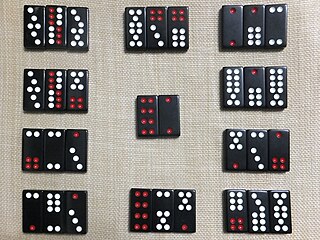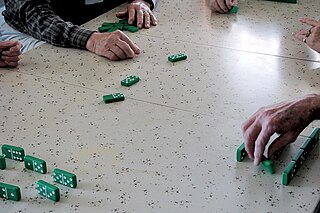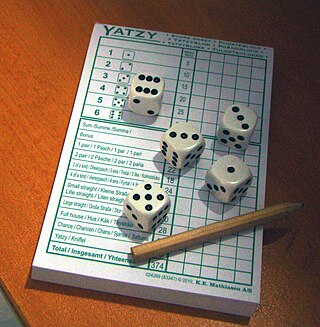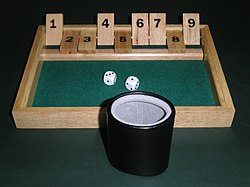
Chinese dominoes are used in several tile-based games, namely, tien gow, pai gow, tiu u and kap tai shap. In Cantonese they are called gwāt pái (骨牌), which literally means "bone tiles"; it is also the name of a northern Chinese game, where the rules are quite different from the southern Chinese version of tien gow.

Dominoes is a family of tile-based games played with gaming pieces. Each domino is a rectangular tile, usually with a line dividing its face into two square ends. Each end is marked with a number of spots or is blank. The backs of the tiles in a set are indistinguishable, either blank or having some common design. The gaming pieces make up a domino set, sometimes called a deck or pack. The traditional European domino set consists of 28 tiles, also known as pieces, bones, rocks, stones, men, cards or just dominoes, featuring all combinations of spot counts between zero and six. A domino set is a generic gaming device, similar to playing cards or dice, in that a variety of games can be played with a set. Another form of entertainment using domino pieces is the practice of domino toppling.

Mahjong or mah-jongg is a tile-based game that was developed in the 19th century in China and has spread throughout the world since the early 20th century. It is played by four players. The game and its regional variants are widely played throughout East and Southeast Asia and have also become popular in Western countries. The game has also been adapted into a widespread online entertainment. Similar to the Western card game rummy, mahjong is a game of skill, strategy, and luck. To distinguish it from mahjong solitaire, it is sometimes referred to as mahjong rummy.
Tien Gow or Tin Kau is the name of Chinese gambling games played with either a pair of dice or a set of 32 Chinese dominoes. In these games, Heaven is the top rank of the civil suit, while Nine is the top rank of the military suit. The civil suit was originally called the Chinese (華) suit while the military suit was called the barbarian (夷) suit but this was changed during the Qing dynasty to avoid offending the ruling Manchus. The highly idiosyncratic and culture-specific suit-system of these games is likely the conceptual origin of suits, an idea that later is used for playing cards. Play is counter-clockwise.
Pips are small but easily countable items, such as the dots on dominoes and dice, or the symbols on a playing card that denote its suit and value.

Triominoes is a variant of dominoes using triangular tiles published in 1965. A popular version of this game is marketed as Tri-Ominos by the Pressman Toy Corp.

Yahtzee is a dice game made by Milton Bradley. It was first marketed under the name of Yahtzee by game entrepreneur Edwin S. Lowe in 1956. The game is a development of earlier dice games such as Poker Dice, Yacht and Generala. It is also similar to Yatzy, which is popular in Scandinavia.

42, also known as Texas 42, is a trick-taking game played with a standard set of double six dominoes. 42 is often referred to as the "state game of Texas". Tournaments are held in many towns, and the State Championship tournament is held annually in Hallettsville, Texas on the first Saturday of March each year. In 2011 it was designated the official State Domino Game of Texas.
Farkle, or Farkel, is a dice game similar to or synonymous with 1000/5000/10000, Cosmic Wimpout, Greed, Hot Dice, Squelch, Zilch, or Zonk. Its origins as a folk game are unknown, but the game dates back to at least the mid-1980s. It has been marketed commercially since 1996 under the brand name Pocket Farkel by Legendary Games Inc. While the basic rules are well-established, there is a wide range of variation in both scoring and play.
Deadwood is a board game for 3–8 players produced by Cheapass Games. In it, players assume the roles of bit actors working for a B-Movie Studio who try to make as much money as possible. This is done by taking on roles such as "man on fire," "woman in black dress," and "falls off roof." Players are represented by dice, which denote what "level" actor each player is. The original version of the game was available through various game outlets. The rules, boards, and cards for a revised edition are now available for free download from the company's website, and are being developed into a deluxe edition via Kickstarter.

Yatzy is a dice game similar to Yacht and Yahtzee. It is related to the Latin American game Generala and the English game of poker dice. Yatzy is most popular in the Nordic countries.

Muggins, sometimes also called All Fives, is a domino game played with any of the commonly available sets. Although suitable for up to four players, Muggins is described by John McLeod as "a good, quick two player game".

Mexican Train is a game played with dominoes. The object of the game is for a player to play all the tiles from his or her hand onto one or more chains, or trains, emanating from a central hub or "station". The game's most popular name comes from a special optional train that belongs to all players. However, the game can be played without the Mexican train; such variants are generally called "private trains" or "domino trains". It is related to the game Chicken Foot.

Bendomino is a tabletop strategy game similar to dominoes, created by Thierry Denoual and published by Blue Orange Games in 2007. It is a set of double-6 dominoes with a 120-degree curve. The main difference from dominoes is the curved shape of the pieces, which introduces a new level of strategy to the game. There is also a version of the game for younger players with pictures instead of numbers and symbols on the Bendomino tiles.

Generala is a dice game similar to the English game of poker dice, the German game Kniffel, and the Polish game Jacy-Tacy (yahtzee-tahtzee). The American variant of Generala, Yahtzee, is the most popular variant. Although it is sometimes played in Europe and the United States, Generala is most popular in Ibero-America.
A number of related games under the Yahtzee brand have been produced. They all commonly use dice as the primary tool for game play, but all differ generally. As Yahtzee itself has been sold since 1954, the variants released over the years are more recent in comparison, with the oldest one, Triple Yahtzee, developed in 1972, eighteen years after the introduction of the parent game.

A game is a structured type of play, usually undertaken for entertainment or fun, and sometimes used as an educational tool. Many games are also considered to be work or art.
The Genius: Rule Breaker is the second season of The Genius, which debuted on tvN on December 7, 2013.
Triangular Dominoes is a variant of dominoes using equilateral triangle tiles, patented by Franklin H. Richards in 1885. Two versions were made: a starter set of 35 unique tiles, with each side numbered from zero to four pips, and an advanced set of 56 unique tiles, with each side numbered from zero to five pips. In both versions, a wild card "boss" tile was included, making 36 and 57 tiles in each complete set, respectively.














